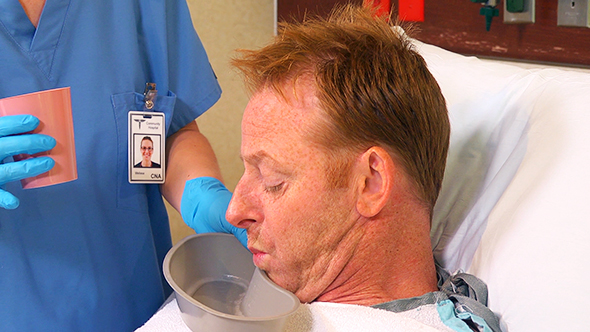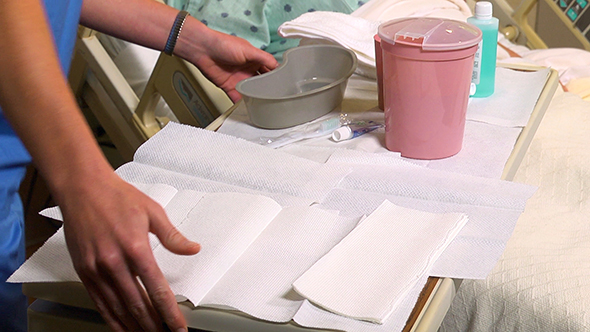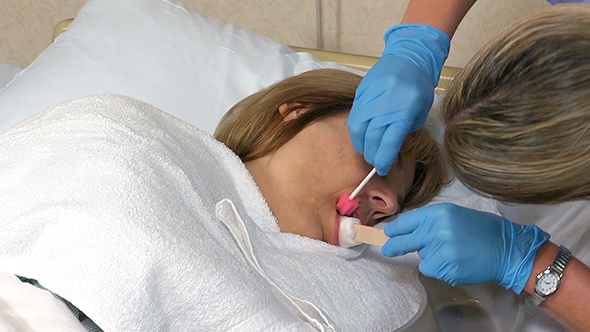Personal Hygiene and Grooming
Select a Skill:
- » Performing Oral Hygiene
- » Providing Denture Care
- » Brushing and Combing the Person's Hair
- » Shampooing the Person's Hair
- » Shaving the Person's Face
- » Giving Nail and Foot Care
- » Assisting with Undressing and Dressing
- » Changing the Gown of the Person with an IV
Take the Review Test:

Purpose

- Oral hygiene (mouth care):
- Keeps the mouth and teeth clean.
- Prevents mouth odors and infections.
- Increases comfort.
- Makes food taste better.
- Reduces the risk of cavities (dental caries) and periodontal disease (gum disease or pyorrhea).
- Oral hygiene involves brushing and flossing teeth. Flossing removes food from between the teeth. It also removes plaque (a thin film that sticks to teeth) and tartar (hardened plaque), which cause periodontal disease.
- Some people need help gathering and setting up oral hygiene equipment. You perform oral hygiene for persons who are very weak, cannot move their arms, or are too confused to brush their teeth.
- For an unconscious person, use sponge swabs to apply the cleaning agent specified in the care plan. Keep the person’s mouth open with a padded tongue blade. Do not use your fingers. Give mouth care at least every 2 hours, following the nurse’s directions and the care plan.
Equipment
Roll cursor over items to see labels. For the purposes of clearly depicting the equipment, a barrier is not shown in this photo. When providing care, a barrier should always be placed on the surface before placing the equipment.

Hand towel
Gloves
Paper towels
Water pitcher
Water cup with cool water
Mouthwash or solution noted on the care plan
Toothbrush with soft bristles
Toothpaste
Dental floss, if used
Kidney basin
Lip lubricant
Sponge swabs
Padded tongue blade (gauze, tongue blade and tape used to make a padded tongue blade)
Delegation
- Follow delegation guidelines. Before performing oral hygiene, obtain this information from the nurse and care plan:
- The type of oral hygiene to give—assisting the person to brush and floss the teeth, brushing and flossing the person’s teeth, or providing mouth care for the unconscious person
- If flossing is needed
- What cleaning agent and equipment to use
- If you apply lubricant to the lips (If so, what lubricant to use)
- How often to give oral hygiene
- How much help the person needs
- What observations to report and record
- When to report observations
- What patient or resident concerns to report at once.
Preparation

- Observe quality-of-life measures.
- Review the information under Delegation and Safety and Comfort.
- Practice hand hygiene.
- Collect the equipment.
- Place the paper towels on the over-bed table. Arrange items on top of them.
- Identify the person. Check the ID bracelet against the assignment sheet. Also call the person by name.
- Provide for privacy.
- Raise the bed for body mechanics. Bed rails are up if used.
Safety

- Follow Standard Precautions and the Bloodborne Pathogen Standard. You may have contact with the person’s mucous membranes. Gums may bleed during mouth care. Also, the mouth has many microbes.
- For an unconscious person, use sponge swabs with care. Make sure the sponge is tight on the stick. The person could aspirate or choke if the sponge comes off.
- To help prevent aspiration in an unconscious person:
- Position the person on one side with the head turned well to the side.
- Use only a small amount of fluid to clean the mouth.
- Do not insert dentures.
Comfort
- Assist with oral hygiene after sleep, after meals, and at bedtime. Many people practice oral hygiene before meals. Some need mouth care every 2 hours or more often. Always follow the care plan.
- Unconscious persons are re-positioned at least every 2 hours. To promote comfort, combine mouth care with skin care, re-positioning, and other comfort measures.
Procedure Video
Audio Description: OFFFollow-up Care

- Provide for comfort.
- Place the call light within reach.
- Lower the bed to the low position. Raise or lower bed rails. Follow the care plan.
- Rinse the toothbrush. Clean, rinse, and dry equipment. Return the toothbrush and equipment to their proper place. Wear gloves.
- Wipe off the over-bed table with paper towels. Discard the paper towels.
- Unscreen the person.
- Complete a safety check of the room.
- Tell the unconscious person that you are leaving. State when you will return.
- Follow agency policy for dirty linens.
- Remove and discard the gloves. Practice hand hygiene.
Reporting/Recording
- Report and record your observations, including:
- Dry, cracked, swollen, or blistered lips
- Mouth or breath odor
- Redness, swelling, irritation, sores, or white patches in the mouth or on the tongue
- Bleeding, swelling, or redness of the gums
- Loose teeth
- Rough, sharp, or chipped areas on dentures
Review Questions
Select the best answer.
1. What is a purpose of performing oral hygiene?
 To remove saliva
To remove saliva To prevent mouth odors
To prevent mouth odors To stimulate circulation to the teeth
To stimulate circulation to the teeth To prevent lower respiratory infections
To prevent lower respiratory infections
Select the best answer.
2. How should you position an unconscious person for oral hygiene?
 Turned onto one side
Turned onto one side Seated in a chair at the bathroom sink
Seated in a chair at the bathroom sink  Seated in bed with the head of the bed raised 90 degrees
Seated in bed with the head of the bed raised 90 degrees Positioned supine with the bed at a comfortable working height
Positioned supine with the bed at a comfortable working height
Select the best answer.
3. Which observation made during oral hygiene for an unconscious person should you report and record?
Select the best answer.
4. When performing oral hygiene, which action should you take to promote safety?
 Perform oral hygiene every 4 hours or more often
Perform oral hygiene every 4 hours or more often Use your fingers to keep an unconscious person’s mouth open
Use your fingers to keep an unconscious person’s mouth open Prevent choking by placing an unconscious person in a sitting position
Prevent choking by placing an unconscious person in a sitting position When using a sponge swab, make sure the sponge is tight on the stick
When using a sponge swab, make sure the sponge is tight on the stick
Select the best answer.
5. To floss a person’s teeth, how should you hold the floss?
 Between the ring fingers of both hands
Between the ring fingers of both hands Between the index fingers of both hands
Between the index fingers of both hands Between the middle fingers of both hands
Between the middle fingers of both hands Between the index finger and thumb of one hand
Between the index finger and thumb of one hand
You have completed the Review Questions for this skill. To take the Review again select the Start Over button. To proceed to another skill select from the dropdown menu. Select the Home or Back button to proceed to the next section.

